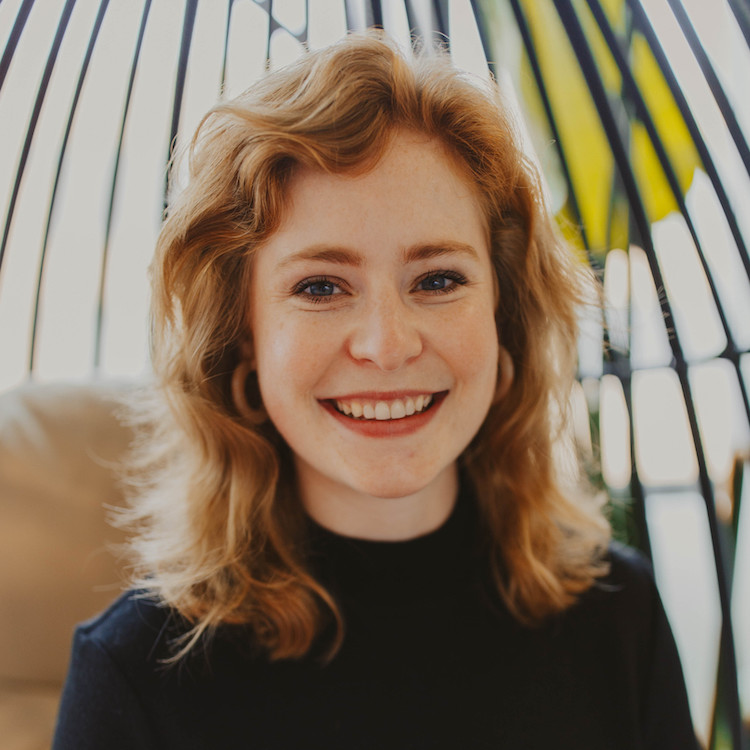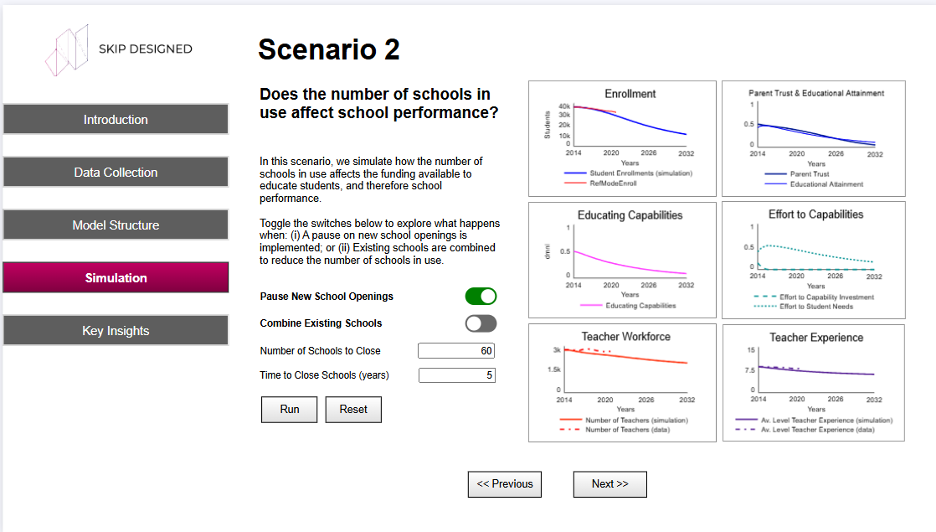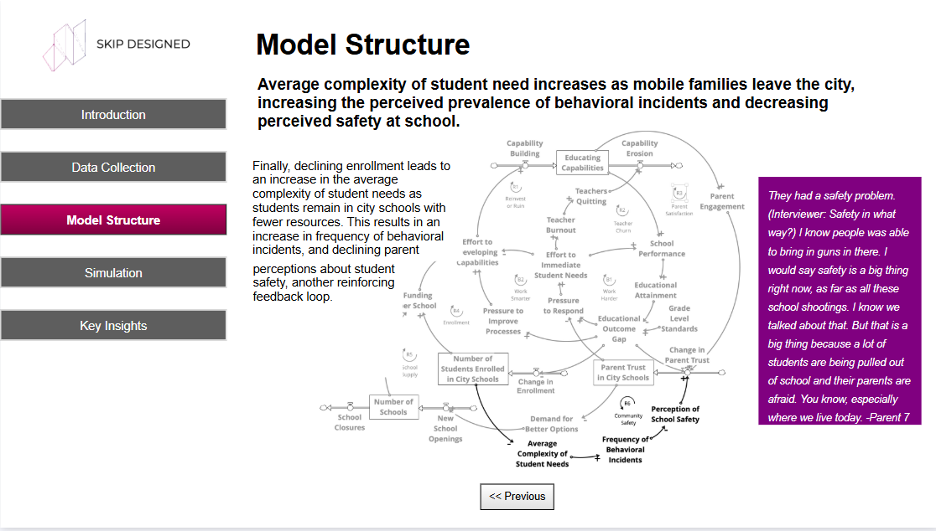SKIP Design pairs Stella® and AI to Tackle Complex Education Issues
 Ellen O'Neill
Ellen O'Neill
There is nothing simple about public education. Public school systems serve whole communities.
They include elementary, middle, high, and charter schools. Students, parents, teachers,
administrators, neighbors, and taxpayers have competing demands, concerns, and worries.
Within that complex environment, schools are mandated to educate students across socioeconomic
levels and learning abilities. And, like all public services, they are expected to meet that
mandate within their community’s budget.
A public school’s funding is linked to the number of students it serves, making decreasing
enrollment a core challenge for many systems. With less funding, schools are forced to slash
programs. As programs that enrich the school experience disappear, well-resourced families might
opt to leave the system leaving classroom with higher concentrations of students with more complex
academic or socio-economic needs. That shift exacerbates teacher burnout. Challenging classrooms,
a beleaguered staff and fewer programs impact educational quality and student achievement.
Decreases in school and student performance drive families away from public schools, completing the loop by causing a drop in enrollment.
Experienced system dynamists, the SKIP Designed team knew that understanding the St. Louis system,
finding reasons for enrollment decline, and testing solutions would require collaborative model
building and simulation. “Stella from isee systems is our gold standard,” says O’Neill.
O’Neill was introduced to Stella by Dr. Saras Chung, her professor at Washington University in St. Louis
and founder of SKIP Designed. Having applied system dynamics and Stella to their work in academia, O’Neill,
Chung, and the SKIP Designed team now take a collaborative, system dynamics approach to helping clients
define their problems, better understand their systems, and find solutions.
SKIP Designed clients, however, are not typically experienced in system dynamics. “We work to make
concepts and technology products accessible to the stakeholder groups that need them,” says O’Neill.
While working with stakeholders in St. Louis to tackle declining public school enrollment, SKIP
Designed worked with isee systems to facilitate their stakeholders’ path from problem definition
to solution identification.
AI-assisted system dynamics
“We started the St. Louis project with an in-depth process that put education leaders and administrators,
teachers, and parents in a room to define their problem and map their system,” says O’Neill. “We were
capturing great qualitative and quantitative data but are a team of just four people. It took a year
just to get the data into a model. New to system dynamics concepts, it was difficult for our clients
to understand and collaborate on the model and they had real urgency. We needed a way to make it easier
for our clients to engage with system dynamics so they could inform the model we were building.”
The SKIP Designed team built CoModel, a simple tool that helps stakeholder groups create simple
causal loops without system dynamics training. Users articulate their problem in CoModel which uses
generative artificial intelligence (AI) to turn their descriptions and problem statements into causal
loop diagrams.
“Having stakeholders create and share their own causal loops and mental maps was an important step,”
says O’Neill. “It brought people together – and there was tension in that room. There were even
lawsuits between a few of the parties. Causal loops, like one showing how staff turnover leads to
teacher burnout, humanized all sides of an issue and neutralized politics. They saw they’re all part
of one system.”
The AI used by CoModel is sd-ai, an isee systems/SKIP Designed collaboration. sd-ai is open source
and acts as an intermediary between any modeling software (such as Stella and CoModel) and AI.
Once stakeholders had created and agreed upon their system’s key causal loops, the SKIP Designed
team used that “rough draft” to create a Stella model. Using Stella Architect, SKIP Designed also
provided an interface that allowed stakeholders to test solution ideas.
Using Stella to test assumptions and solutions
“When we had a functional, agreed upon model, we used it to understand why families, especially
the most economically mobile families, were leaving the school system,” says O’Neill. “The best
high school in Missouri is located in St. Louis. What was pushing people out of the city?”
One obvious explanation for decreasing school enrollments was the opening of new charter schools,
which spread the already decreasing student population across more schools. With fewer students,
schools lose resources, struggle to retain teachers, and fail to increase or even maintain
educational quality and student performance. Perceiving a degradation in quality, families
that are able to move away from the school system. Closing schools to concentrate resources
in those that remained seemed like a good solution.
“Using the Stella model, stakeholders found that that 60 or more schools would have to close
before remaining schools showed improvement in capabilities and capacity,” says O’Neill.
“That wasn’t going to happen. They also discovered that opening more schools would not have
the expected effect on increasing enrollment.”
 Stakeholders tested assumptions about the impact of school closures and openings on educational capabilities,
teacher retention and experience, and parental trust.
Stakeholders tested assumptions about the impact of school closures and openings on educational capabilities,
teacher retention and experience, and parental trust.
In addition to engaging stakeholders in mental mapping and idea testing, the SKIP Designed
team went into communities to gather data from parents. “Our surveys found that community
safety was a key factor in school enrollment,” says O’Neill. “Parents were concerned about
crime, especially violent crime. If a kid can’t walk to school safely, that’s a big problem.”
When crime drives people out of the city, they leave behind properties that often sit vacant.
Vacant shops and houses decrease the tax base and school funding – and vacant real estate
often attracts more crime. Meanwhile, as economically mobile families leave the city, schools
are left with higher concentrations of students who need extra academic and behavioral support.
 St. Louis school system model that shows the relationship of parental perception of safety to school enrollment
St. Louis school system model that shows the relationship of parental perception of safety to school enrollment
While having an important relationship to enrollment decline, community crime was outside
the school system’s control, as were the types of students who were to leave and remain.
Still, it was important for stakeholders to recognize and consider the impact of outside
influences on their system.
Another factor in enrollment decline was embedded in the school system. “The St. Louis system
of public and charter schools is complicated,” says O’Neill. “Some elementary schools are K-3,
others are K-5. Parents have to choose the middle and high schools their student will attend
next. There’s real decision fatigue, especially for families with multiple kids.”
There’s also decision stress. A student might apply to a charter school and not get accepted.
They might lose in a lottery for their public school of choice. What happens then?
Choice options and outcomes add uncertainty to a student’s educational path. For some
families, moving to a district with assigned schools and proven quality is the more
attractive educational strategy.
This project has uncovered several reasons for enrollment decline and is spurring progress
towards improvements. “The group was able to make shifts in their mental model,” says O’Neill.
“There is mutual understanding of the system and how it works and people are ready to collaborate
on positive leverage points.”
For example, with a better, shared understanding of how school capabilities relate to student
enrollment, schools have started to identify and share areas of strength. “Rather than going
it alone, schools are connecting and learning from one another,” says O’Neill.
Stakeholders are continuing to use the Stella model to test ideas for system-wide
improvements. Some St. Louis schools are customizing the model to answer questions specific
to their own location.
Applying Stella and CoModel to new projects
Expanding on the funding and enrollment questions, SKIP Designed is also looking into teacher
retention, an important factor in school performance improvement. “We want to understand what
keeps teachers in the profession and St. Louis in particular,” says O’Neill. “Like the enrollment
decline model, we’ll gather qualitative data from teachers, hold community listening sessions,
and use CoModel to build a mental model that will inform Stella modeling and simulation.”
O’Neill and the SKIP Designed team are most enthusiastic about using CoModel to orient fifth
grade students to thinking systemically. “Kids naturally think in systems, but schools don’t
encourage it and, by high school, they’re focused on dates and facts,” says O’Neill. “We’re
really excited to teach system dynamics to the next generation of problem solvers.”
Stella and CoModel are also at work in several other St. Louis projects. “We’re in the early
days of a city-wide project that looks at factors in urban growth,” says O’Neill. “We’re
taking an inverse approach to the enrollment decline project. First, we’re using Stella to
create a generic city model that includes things like housing, innovation, and transportation.
Next, we’ll collect qualitative information through interviews with community members and work
with stakeholders and CoModel to build causal maps that inform and improve the Stella model.”